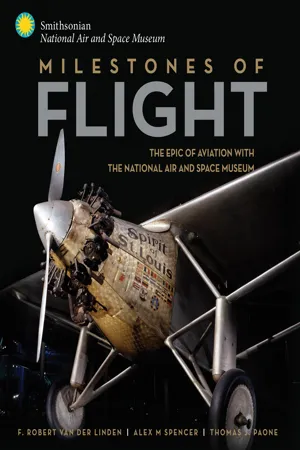
Milestones of Flight
The Epic of Aviation with the National Air and Space Museum
- 208 pages
- English
- ePUB (mobile friendly)
- Available on iOS & Android
Milestones of Flight
The Epic of Aviation with the National Air and Space Museum
About This Book
Experience the history of flight with the world-class aviation collection at the Smithsonian's National Air and Space Museum, which attracts millions and millions of visitors each year in Washington, D.C.
From the moment the Wright Brothers first took flight in 1903 to the modern-day reliance on stealth aircraft and drones, there have been significant advances made in aviation. Milestones of Flight celebrates each era of advancements by showcasing the Smithsonian National Air and Space Museum's world-class aircraft collection. Authored by Dr. Robert van der Linden, a leading expert on aviation and Chairman of the Aeronautics Department at the NASM, this book is a stunning profile of the advancements in flight from decade to decade, illustrated with beautiful, large-scale photography and enhanced with little-known facts, anecdotes, and insights from major players in the aviation industry.
Climb inside the cockpit of the Spirit of St. Louis that Charles Lindbergh piloted solo across the Atlantic Ocean, making history. Contrast that with a Boeing B-29 Superfortress, the first aircraft to drop an atomic bomb. The full-page photos of each milestone-making aircraft are accompanied by timelines to showcase related aircraft as well as sidebars with interesting and little-known facts, stories, and related research.
Milestone categories include:
- Era of Early Flight
- World War I First Fighters
- Long-Range Record-Setting Flight
- Popular Flight
- First Commercial Airliners
- World War II Aircraft
- Experimental Flight
- Cold War Military/Korean Conflict Aircraft
- Commercial Jets
- Modern Military Aircraft
What will the next milestone be?
Frequently asked questions
Information
CHAPTER 1
1903 WRIGHT FLYER

1903 WRIGHT FLYER
1878 | Milton Wright gives toy helicopter to sons Orville and Wilbur |
1899 | May 30: Wright brothers contact Smithsonian for aeronautical data to begin their research |
1903 | December 17: Wrights achieve first powered heavier-than-air human flight |
1913 | March: Flyer is damaged by flood in Dayton, Ohio |
1916 | Summer: Orville Wright repairs Flyer for display at Massachusetts Institute of Technology |
1928 | Orville Wright lends Flyer to Science Museum in London over controversy with Smithsonian Institution |
1938–1945 | Flyer stored in Corsham, England, to protect from damage |
1948 | January: Orville Wright dies and bequeaths Flyer to Smithsonian December: Flyer goes on display at Smithsonian |
1985 | Smithsonian performs conservation work on Flyer and replaces fabric covering |
Table of contents
- Cover
- Title Page
- 1. 1903 Wright Flyer
- 2. 1909 Wright Military Flyer and 1911 Wright EX Vin Fiz
- 3. Blériot XI and Curtiss D-III Headless Pusher
- 4. Caudron G.4
- 5. Douglas World Cruiser DWC-2 Chicago
- 6. Ryan NY-P Spirit of St. Louis
- 7. Lockheed Vega 5B and Lockheed Vega 5C Winnie Mae
- 8. Piper J-3 Cub
- 9. Explorer II
- 10. Douglas DC-3
- 11. Douglas SBD-6 Dauntless
- 12. North American P-51D Mustang
- 13. Bell XP-59A Airacomet
- 14. Messerschmitt Me 262A 1-a Schwalbe (Swallow)
- 15. Boeing B-29 Superfortress Enola Gay
- 16. Little Gee Bee
- 17. Bell XS-1/X-1
- 18. North American F-86A Sabre
- 19. Boeing 367-80
- 20. McDonnell F-4S-44 Phantom II
- 21. North American X-15
- 22. Arlington Sisu 1A
- 23. Bell UH-1H Iroquois “Huey” Smokey III
- 24. Lockheed SR-71A Blackbird
- 25. Aérospatiale-BAC Concorde
- 26. General Atomics MQ-1L Predator
- Image Credits
- Index
- Copyright